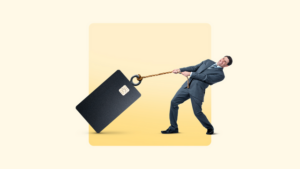What is debt forgiveness?

Key takeaways
- With debt forgiveness, creditors pardon some or all of your debt.
- Various types of debt may qualify for forgiveness.
- Debt forgiveness can offer relief from overwhelming financial burdens, but it does have downsides.
- Debt forgiveness is only one option for managing difficulties with repayment.
Struggling with debt can feel overwhelming. Households currently hold around $18.39 trillion in debt, according to the latest data from the Federal Reserve. However, you may be able to use debt forgiveness or debt relief to lower or even eliminate debt like personal loans, student loans and credit card accounts.
However, there are important factors to consider when pursuing debt forgiveness. You should be aware of how the service may affect your credit score, taxes and future loan or credit card applications. By knowing how debt forgiveness works, you can make a more informed decision about whether this option is right for you.
How debt forgiveness works
Debt forgiveness — also commonly referred to as debt cancellation or debt relief — is what happens when a creditor writes off some or all of your debt. There are several circumstances in which debt forgiveness can occur, such as government initiatives, financial hardship or debt relief programs.
Lenders apply debt forgiveness in several ways, including through directly negotiated settlements or government programs. You can also approach industry professionals, such as debt counselors, to assist with repayment plans.
However, it’s important to keep in mind that debt forgiveness is relatively rare. In addition, many lenders don’t offer debt relief programs at all. Help is more readily available for unsecured debts, for which there is no collateral, such as personal loans and credit cards. On the other hand, secured debts such as mortgages and car loans are typically not eligible for debt forgiveness.
“Unless you target specific programs like Public Service Loan Forgiveness, it’s best not to count on any form of debt forgiveness,” says R.J. Weiss, certified financial advisor and the CEO of The Ways to Wealth. “While you may hear more about it during election cycles, it’s important to take these promises with a grain of salt. Additionally, it’s rare for private companies to flat-out forgive debt outright — this typically only happens in bankruptcy. In the private sector, if any form of debt relief is offered, it often comes with significant strings attached.”
Types of debt forgiveness
The type of debt forgiveness varies depending on the debt you want forgiven. You may also need to meet certain qualifying criteria before lenders will consider loan forgiveness.
Student loan debt forgiveness
Thanks to the rising costs of a college education, many graduates face the daunting task of repaying substantial student loans. As of June 2025, the combined amount of U.S. student loan debt was $1.81 trillion, according to the Federal Reserve System.
Depending on your job, the type of loan you’ve received, where you studied and how much of your loan you’ve paid off, you may have a few choices for student loan debt forgiveness. However, note that these options are available only to individuals with loans made by the federal government. Loans issued by private lenders are not eligible for the following programs.
Public Service Loan Forgiveness
The first option is the Public Service Loan Forgiveness Program (PSLF). This initiative provides debt forgiveness if you work for the government or a nonprofit organization and you’ve met the following criteria:
- You’ve already made the equivalent of 120 months of qualifying payments under a repayment plan. This means that you’ve paid at least the minimum amount due on time every month.
- While making these payments, you’ve worked full-time for qualified types of employers — for example, a local, state or federal government agency or a nonprofit organization.
Income-Driven Repayment
The other option is the Income-Driven Repayment (IDR) Plan, which caps your repayments according to your income and family size. After 20 or 25 years of repayments, the balance of the loans may be forgiven. Plans under this category include:
- Pay As You Earn (PAYE) Repayment Plan
- Income-Based Repayment Plan (IBR)
- Income-Contingent Repayment Plan (ICR)
Some states and employers may also offer help with student loan debt. While student loan forgiveness can be a huge relief, it’s critical to understand the details of your particular loan.

Pros
- You may be able to pay less on your student loan repayments.
- Several federal debt forgiveness programs are available.
- Some career paths may offer specialized forgiveness programs.
- Even partial forgiveness can provide significant relief.

Cons
- Private student loans typically do not qualify for forgiveness.
- Forgiveness processes usually take time.
- Eligibility criteria are stringent.
- Individuals who have defaulted on loans are generally ineligible for forgiveness.
Medical debt forgiveness
Unexpected medical expenses can accumulate quickly, leading to overwhelming debt. Fortunately, there are processes to help with this type of debt through medical debt forgiveness programs.
If you are struggling with medical debt, a good first step to take is to contact the medical facility where you incurred the debt. You can inquire about their financial assistance policy, which is often referred to as charity care and is legally required for nonprofit hospitals by most states.
The hospital may significantly reduce your bill or even forgive it entirely. Common qualifying criteria for medical debt forgiveness include:
- Income: The extent of the forgiveness will depend on the applicant’s income and finances. Those in financial hardship are more likely to qualify for full debt forgiveness.
- Uninsured or underinsured: Those without insurance or whose insurance doesn’t cover all the expenses may qualify for forgiveness. This is especially true for catastrophic medical events where even reasonable health insurance won’t cover the costs.
- No source of payment: When a debtor has no funds available for repayment, debt forgiveness might apply.

Pros
- Even if you do not qualify for complete forgiveness, financial assistance may be available.
- Medical debt forgiveness is awarded on a sliding scale with no set limit on how much you need to earn.
- If you don’t qualify for forgiveness, there may be ways to get your bill reduced.

Cons
- Securing medical debt forgiveness can be time-consuming and laborious, with no guaranteed outcomes.
- You may need to provide the medical institution with documentation like tax returns and pay stubs to prove your need.
Tax debt forgiveness
Unpaid taxes can result in significant financial strain, but the Internal Revenue Service (IRS) provides several options for taxpayers facing financial hardship. One common method is the Offer in Compromise (OIC) program, which allows taxpayers to settle their tax debt for less than the full amount owed. The IRS will consider your income, expenses and assets to determine a reasonable settlement amount.
However, the IRS doesn’t approve every application for OIC. The IRS requires you to meet strict criteria to show that paying the full amount owed would truly create a financial hardship.
Installment agreements provide another avenue, allowing taxpayers to pay their debt over time in manageable monthly payments. Additionally, the IRS may offer penalty abatement or other forms of relief for eligible individuals.

Pros
- Get immediate relief from the burden of owing taxes.
- Potentially settle your tax debt for less than the full amount owed.
- Avoid harsh collection actions such as wage garnishment or asset seizure.

Cons
- Tax debt forgiveness may have implications for future tax filings, and forgiven debt may be considered taxable income.
- Engaging with the IRS can be complex and time-consuming.
- The IRS’s strict criteria mean you may not be eligible for the OIC program.
Mortgage debt forgiveness
Technically, mortgage debt isn’t forgiven unless there is a deficient balance after the sale or foreclosure of a property. If a borrower is struggling to make payments, the options are:
- Bankruptcy: Certain types of bankruptcy allow you to keep your assets by restructuring your payments, but the debt won’t be forgiven.
- Foreclosure: When you’re unable to make the agreed payments, and loan modifications or bankruptcy are no longer an option, the bank may move to repossess your home and collect whatever it can by selling it.
- Loan modifications: The lender agrees to modify your loan to reduce your monthly payment. One way they can do this is by extending the term of the loan.
If the lender agrees to any degree of debt forgiveness through loan modification or foreclosure, there are a few pros and cons to consider.

Pros
- Loan modification may allow you to avoid foreclosure and its damaging effects on credit.
- You can reduce or eliminate a significant portion of mortgage debt if you owe more than the property is worth during foreclosure.
- Get relief from the stress and uncertainty of struggling to make mortgage payments.

Cons
- Mortgage debt forgiveness may have tax implications.
- Homeowners may have difficulty qualifying for loan modifications and navigating complex lender negotiations.
- Foreclosure damages your credit score and remains on your report for seven years.
Credit card debt forgiveness
Credit card forgiveness is rare. Card issuers typically expect individuals to repay the amount borrowed, and high-interest credit card debt can be difficult to overcome.
While forgiveness typically isn’t an option, you can pursue debt relief options.
- Bankruptcy: You can file for bankruptcy, which in certain cases includes full or partial debt forgiveness.
- Balance transfers: You can consider taking out a personal loan or opening a zero-interest credit card to transfer your balance and pay off your debt.
- Debt management plans: A debt counselor will work with your lenders to create a suitable repayment plan. They won’t negotiate a lower settlement amount but will request reduced interest rates and fees to help you get out of debt faster.
- Debt settlement: This is when you negotiate to settle the debt for a lump sum to guarantee payment. However, this process may hurt your credit score, and there’s no guarantee that a creditor will accept the offered settlement amount.
- Hardship programs: Some lenders may agree to assist with loan forgiveness if you can prove severe financial hardship, such as becoming disabled.
Consider the pros and cons of credit card forgiveness before pursuing this route.

Pros
- Credit card refinancing may be available at a lower interest rate, saving you money in the long term.
- A consolidation loan simplifies your finances by reducing several credit card payments to just one monthly payment.

Cons
- Debt management companies often charge fees, increasing how much money you owe overall.
- If you don’t take quick action with a debt consolidation loan, your credit card payments may become overdue and hurt your credit score.
Alternatives to debt forgiveness
If you don’t qualify for any debt forgiveness programs, there are alternative debt management options to help you repay and manage your debts:
- Debt consolidation: Debt consolidation merges multiple debts into a single loan, typically with a lower interest rate. This can simplify payments and potentially reduce overall debt.
- Credit counseling: Seeking guidance from accredited credit counseling agencies can help you create realistic budgeting strategies and debt management plans.
- File for bankruptcy: In extreme cases where debt is insurmountable, filing for bankruptcy may offer a fresh start by liquidating assets or establishing a repayment plan.
Bottom line
Debt forgiveness can offer you a fresh start on your financial journey. However, some debt forgiveness programs have strict qualification requirements. Before pursuing any debt relief option, familiarize yourself with the qualifications, required documentation and the specific circumstances under which you may apply.
In addition, it’s important to consider how debt forgiveness might affect your credit score, since this can impact your ability to qualify for future loans. Proper preparation and awareness of the long-term financial implications are crucial for making an informed decision.
Frequently asked questions
Why we ask for feedback Your feedback helps us improve our content and services. It takes less than a minute to complete.
Your responses are anonymous and will only be used for improving our website.







